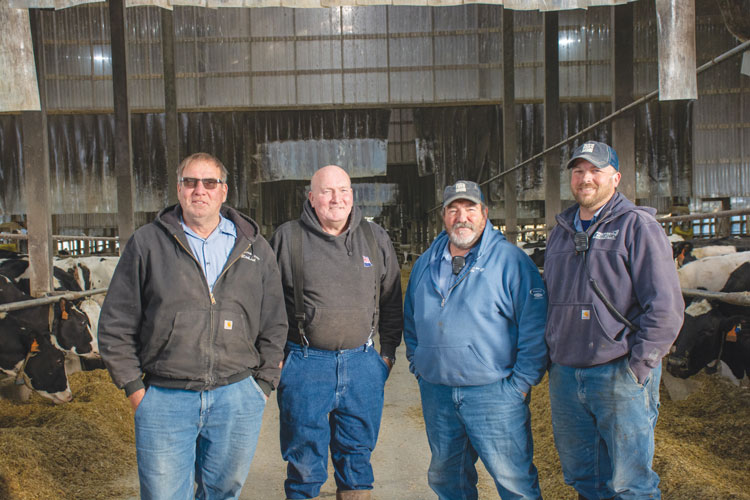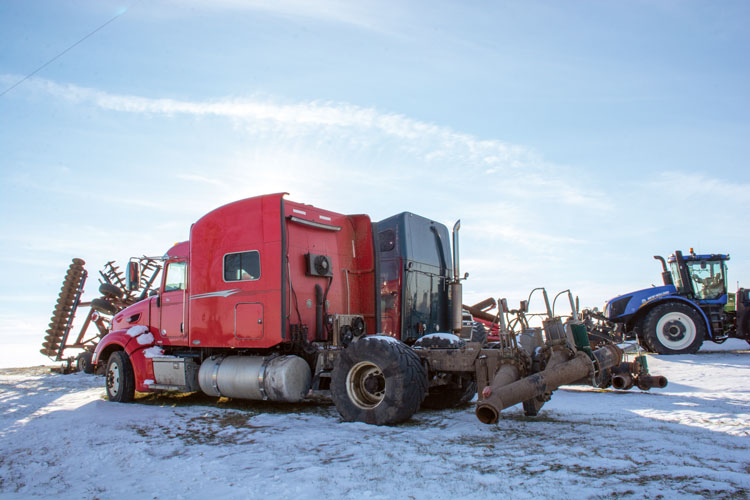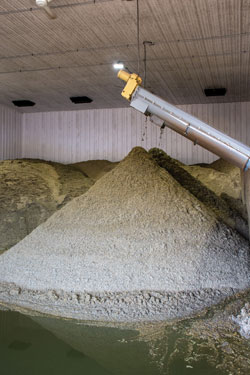
The old saying, “Don’t put your all your eggs in one basket,” is a mantra for the Johnson family of Peterson, Minn. Their farm consists of dairy cattle, hogs, and land for cash cropping, and they feel this diversity has been one of their keys to success.
The management team at Johnson’s Rolling Acres includes three senior partners – brothers Richard, Mark, and Bradley Johnson – and three junior partners – cousins Zac, Lee, and Trinity Johnson. These men follow in the footsteps of their father and grandfather, LeRoy Johnson.
More seats at the table
LeRoy and his wife, Darleen, raised 13 children on their dairy and hog farm. When several of them expressed interest in joining the farm after school, LeRoy wanted to be sure there was room for everyone in the business. So, he established a corporation in 1979 and continued to grow the farm. Over time they started milking more cows, added more hogs, and expanded their land base.
“My dad liked to buy land,” said Bradley, “and we have always been able to use land.” This land provides plenty of room to grow feed, spread manure, and served as collateral when financing future projects. With more acres and more areas of the farm to manage, several of LeRoy and Darleen’s children were able to make a career on the farm.
“They tried to set things up so there was an opportunity to enter the farm,” Richard explained. “They spent a lot of time planning their exit strategy while also creating an opportunity for the next generation.”
Richard and his siblings carried on that way of thinking, establishing a plan so that the next generation of Johnsons could join the farm. “It is really important motivation for the next generation to know early on what they are working for,” he said.
“We felt like it was necessary for the young guys to know what their future would look like,” agreed Mark. This planning process also provides a path for the older generation to retire when they are ready. “So, there is a double benefit,” he added.
In 2000, the Johnsons built a new parlor and went from 150 to 600 cows. They reached 1,200 cows by 2012, which is their cap based on a county-imposed limit.
Trinity’s dad was not one of the partners on the dairy, but he started working on the farm at a young age and knew he wanted to be involved. He was the first of the third generation to rejoin the operation, but before he did, he went to college, worked off the farm, and then completed a two-year internship on the dairy before being voted in as a partner.
Those are the parameters set by the farm for anyone wanting to join the team: complete at least two years of college, work two years off the farm, and then intern at the farm for two years.
Even though Trinity, Lee, and Zac all knew they wanted to farm, they agreed that working somewhere else was beneficial and helped them gain more specialized skills. They would set similar expectations for the next generation if they choose to join the farm someday.
Room to specialize
The partners all agree that diversification has been a strength for their farm and family and has served them well. It provides opportunity, security, and a future for the farm.
This diversity gives each person an area to focus on. Richard is the overall farm manager. Bradley oversees the hog operation. Mark is in charge of the dairy herd, with Trinity also working in that area. Lee manages the diesel shop and crew, and Zac heads up the agronomy side of the farm.
“Diversification is part of our culture,” said Richard. “It created an opportunity for individualism while still working together.”
Today, the Johnsons are milking 1,160 cows three times a day in a double-18 parallel parlor. The Holstein herd averages 27,575 pounds of milk, with 4.6% fat, 3.3% protein, and a 160,000 somatic cell count.
The cows are housed in a 6-row tunnel ventilated barn or their newer 8-row cross ventilated barn. The stalls are sand bedded, and cooling cells and sprinklers help aid in cow cooling. Their goal is to make the cows as comfortable as possible. “If the cows are happy, we are happy,” Trinity noted.
Their cropping enterprise consists of around 3,500 acres. About three-fourths of that land is used to grow feed for their animals; the remaining acres are used for cash cropping.
On the hog side, they bought into a sow cooperative in 1998 and have 8% ownership. They have four swine barns and market around 10,000 hogs a year.
Manure from the swine operation is held in underground storage beneath the barns with a year’s worth of capacity. On the dairy side, their freestall barn alleyways are flushed and sand is separated utilizing a flush flume system and two screw presses. They are able to reclaim 85% to 90% of the sand.
After the sand is separated and washed, it is stacked. The addition of a sand shed allows them to now wash sand 365 days a year. In the winter, Zac noted it is a relatively quick turnaround, with sand being returned to the stall beds two to three weeks after it was washed.
Extra sand is stacked on a concrete pad. A major benefit of sand washing is that they can maintain a smaller sand inventory, and the recycled sand has worked well for them in terms of cow health and performance.

Moving the manure
The Johnsons do all their own pumping and application with 4 miles of draglines. They dragline all the dairy manure and most of the swine manure. They will tank some swine manure to fields further away.
The first stage of their lagoon captures manure, water, and the remaining sand. It has a concrete floor, so once a year they go in with a payloader and remove that sand. They start by emptying the first pit, then move onto the second stage and finally the main storage.
About two-thirds of their manure is applied in the fall and the rest is done in the spring. With a land base that is in close proximity to the main farm, they feel fortunate to have plenty of room to spread these valuable nutrients. They also transfer some of their manure to neighbors’ fields, only charging them their application costs, so it’s a win-win for both sides, Zac said.
One unique feature is that they use idling semitrucks to run their pumps. The rear axles are removed and they worked with Chris Lindstrom of Durand, Wis., to install the specialized electronics into the trucks. “It works pretty good,” Zac said. At first, they had to have someone stationed at each pump, but now they can control the pumps through their phones, which frees up two people to do other tasks.
Another noteworthy investment was the purchase of a bigger toolbar that allows them to spread manure more evenly, which Zac said has been a positive change.
According to their nutrient management plan, they are required to take manure samples from each hog site annually. For the dairy manure, they take samples at the start of application, in the middle, and at the end. They have found that these samples don’t fluctuate much year to year.
They soil sample all of their fields on a three-year rotation, and they will supplement with commercial fertilizer as needed.
Cover crops are also a piece of their nutrient management strategy. Zac said they try to establish rye on their 650 acres of corn silage ground after harvest. Successfully establishing a cover crop can be difficult some years in their more Northern climate, but Zac feels it is worth the effort, especially in the spring when growing plants with a good root system can help prevent washouts from heavy rain. There are advantages in weed control as well.
“Overall, it is a benefit to the farm, even with the extra work,” Zac noted. They terminate the rye and work it in prior to planting.
True to their roots
Looking forward, their plans may include more diversification since they can’t grow their dairy herd size at the current location. “We could expand to another site, but is it feasible economically and environmentally to have two sites?” Richard asked rhetorically.

That environmentally friendly, sustainable piece is very important to them, and they are careful to use the products at their disposal accordingly. While some may see manure as a hassle, they don’t consider it to be, and it fits into their sustainability puzzle.
“If every ounce of waste is used as nutrients for crops, is it really a waste?” Richard asked. “We get these nutrients from our own cows and hogs. What’s better for the world?”
“Dairy is one of the most environmentally friendly, sustainable industries,” Zac added. One example of this sustainability is how they use recycled water to flush their alleys and wash their sand, which is then reused as bedding. They also feel like they are doing good both environmentally and economically when they recycle manure as a nutrient source.
“I feel fortunate on the agronomy side to have it, especially when commercial fertilizer prices have been through the roof,” said Zac. “Any acres we can cover with manure is a benefit for us.”
Their commitment to the environment includes a close relationship with their Soil and Water Conservation District and involvement with local water quality monitoring projects. They are also very community-minded, offering tours of the dairy and hosting June Dairy Month events. For the past few years, they have been purchasing milk for a local preschool that was previously serving juice to their young students.
In addition, they also strive to help the community by serving as a valuable employer for those who work with them. Several members of their team have been with the farm for years, a testament to the quality of their workplace.
A diverse business, a management team with their own areas of strength, facilities designed with animal needs in mind, and enough land to grow crops and apply manure are all part of the Johnson family’s success. As they look to the future, they also reflect on where their farm began.
“We are always trying to find little things to do better,” Zac said. “I think we would be making LeRoy proud.”









